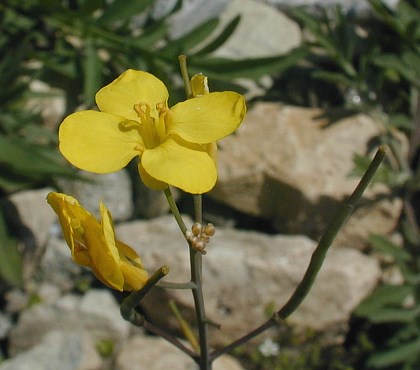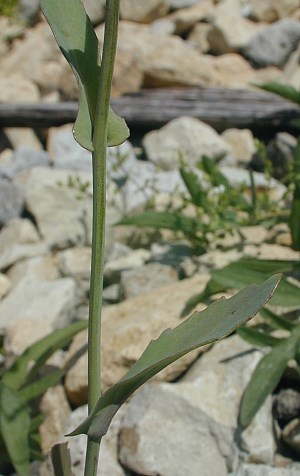Description: This plant is an annual or biennial about 1-3' tall. Small plants are branched sparingly, while large plants branch abundantly in the upper half. The stems are gray-green or gray-blue, terete, glabrous, and glaucous. Plants that begin growth during the fall will overwinter as low rosettes with basal leaves, while plants that begin growth during the spring bolt upward almost immediately. Both the basal and lower leaves are up to 10" long and 2" across, but they are usually smaller than this. They are oblanceolate in overall shape and strongly pinnatifid with undulate or bluntly dentate margins; their terminal lobes are the largest in size. Both types of leaves have stout petioles. In contrast, the middle to upper leaves are smaller in size, lanceolate-oblong in shape, with margins that are smooth or bluntly dentate. These latter leaves have bases that usually clasp their stems, although some of them may be sessile. Like the stems, these various leaves are grey-green or blue-green, glaucous, and usually glabrous – occasionally the basal leaves have short bristly hairs. The lower, middle, and upper leaves are alternate.

The upper stems
terminate in racemes of bright yellow flowers. The flowers bloom toward
the apex of each raceme, while the seedpods develop below. Each flower
is 1/3–1/2" (8-12 mm.) across, consisting of 4 yellow petals, 4 green
to yellow
sepals, several stamens, and a pistil with a single style. The sepals
are narrowly lanceolate and hairless. The blooming period can occur
anytime between late spring to early fall; it usually lasts about 1
month for a small colony of plants. Each flower is replaced by an
ascending cylindrical seedpod (silique) that is 1¼–2¼" long at maturity
and hairless. Each seedpod terminates in a seedless beak that is about
one-fourth its entire length. At the base of each seedpod, there is a
stout hairless pedicel about ½" long that is widely spreading to
ascending. Each seedpod divides into 2 valves to release its small
globoid seeds. The root system consists of a taproot. This plant
reproduces by reseeding itself.
Cultivation:
Rape Mustard prefers full sunlight, moist to dry conditions, and a
neutral to alkaline soil containing loam, clay-loam, or gravelly
material. The size of individual plants varies greatly according to
moisture conditions and soil fertility.
Range & Habitat:
Rape Mustard is occasional in most areas of Illinois (see Distribution
Map). It is native to Eurasia. Typical habitats include
cropland, weedy fields, roadsides, gravelly areas along railroads, and
waste areas. This plant is usually found in areas with a history of
disturbance where there is scant ground vegetation.

Faunal
Associations:
The nectar of the flowers attracts small bees and White butterflies
(Pieridae); some bees may collect pollen from the flowers as well. The
caterpillars of the butterflies Pieris napi
(Mustard White), Pieris rapae (Cabbage White), and Pontia
protodice (Checkered White) feed on Brassica spp.
(Mustards), as do the caterpillars of the moths Evergestis
pallidata (Purple-Backed Cabbageworm) and Plutella
xylostella (Diamondback Moth). Several species of flea
beetles (primarily Phyllotreta
spp.), Murgantia histrionica (Harlequin
Bug), and Adelphocoris superbus (Meadow Plant Bug)
also feed on the foliage of these plants. The oily seeds of Rape
Mustard and similar species are eaten by the Mourning Dove and
Ring-Necked Pheasant, and the mild-tasting foliage can be eaten in
limited amounts by livestock and other mammalian herbivores.
Photographic Location:
A gravelly area along a railroad in Savoy, Illinois.
Comments:
This is another weedy mustard species from Eurasia. It should not be
confused with the agricultural crop, Oilseed Rape (or Canola), which is
Brassica napus oleifera, or one of the cultivated
vegetables. Rape Mustard has several common names, including Field
Mustard and Birdseed Rape. In general, Rape Mustard can be
distinguished from other Brassica spp. (Mustards)
by its glaucous gray-blue or gray-green foliage and its clasping
alternate leaves. A similar species, Brassica oleracea
(Wild Cabbage), shares these characteristics, but this latter species
has larger flowers (exceeding ½" across) and it is quite rare in
Illinois. Oilseed Rape has foliage that is more green than either Rape
Mustard or Wild Cabbage, and its foliage isn't glaucous.